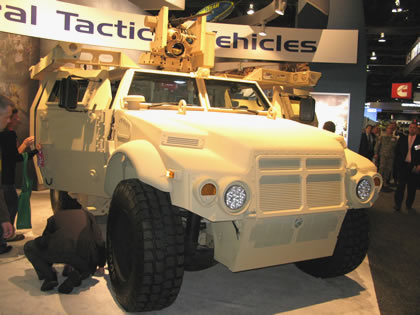AUSA, Washington DC, October 2009: More details on the Joint Light Tactical Vehicles (JLTV) have emerged recently with ongoing Technology Demonstration (TD) phase underway, with each of the three teams producing three basic configurations of the vehicle: Category A with payload capacity of 3,500 lb, seating four soldiers, B category carrying 4,000-5,000 lb payloads and seating six soldiers and Category C – utility prime-mover and ambulance, seating a crew of two and carrying up to 5,100 lb of payload. A common trailer is also part of each vehicle family. Once the vehicle enters production, JLTV is expected to become one of the largest military vehicle acquisition programs worldwide, hence, the US is inviting international partners to ‘buy-in’ their place in the project, similar to the Joint Strike Fighter (JSF) program. Interested nations must be fully on-board, prior to the beginning of the request-for-proposal process, expected after the current technology evaluation phase.
The first partner already signed in for the program is Australia, joining the TD phase by funding and testing eight test vehicles. Further participation with the U.K., Canada and Israel is also in discussion. While the TD phase could be too early for international partners to consider, the following Engineering, Manufacturing Development (EMD) and Production phases are more likely and will also be open for local and international competition. The Army and Marine Corps managing the program are considering multilateral or bilateral project arrangements for the EMD phase using the ‘buy-in’ approach, where cooperating nations will be required to pay to become a program partners. Interested nations must be fully on-board prior to the beginning of the EMD Request for Proposal (RfP) process. At the AUSA exhibition in October 2009 the BAE Systems-Navistar and Global Tactical Vehicles (GTV) teams both displayed Category B vehicles, while Lockheed Martin brought the new ambulance version of its Category C variant.
The Valanx vehicle built by the BAE Systems/Navistar team is built of an armor grade aluminum monocoque V-hull, providing basic small arms and mine protection in the basic design. Additional protection B-kit provides enhanced protection with thicker transparent glass, hybrid laminates of advanced armor steel and alumina providing side protection and titanium plates augmenting the underbody protection. The Valanx is powered by an International 6 liter V8 diesel engine coupled with an Allison 2500 6 speed automatic transmission and Cushman transfer case. The power pack employs a starter generator delivering 20 kW of electrical power on-board and 10 kW exportable power. Off-road mobility is enhanced by the independent, double control arm/ airbag suspension with active damped and adjustable height. Four wheel steering is provided in the longer (B and C) versions to reduce turn radius and improve mobility over rough terrain. The A category vehicle is shorter and is not equipped with the rear wheel steering.
GTV is building a single vehicle type common to all categories, extended in the B and C categories by the use of an interlocking trailer extension. The vehicle’s V-shaped monocoque hull is fabricated of aluminum, augmented with space frame in the upper section. B-kit armor enhancements employ ceramic armor appliqué; with segmented underbody protection made of alumina, and enhanced transparent armor on the windows. GTV is powered by the General Engines Products twin turbocharged I-6 Optimizer 3200 diesel engine delivering 300 and 500 hp, to suite the different weight classes. The powerpack includes the Allison automatic transmission with six speeds, a transfer case supporting high-low lock and four wheel drive. The vehicle has fully independent, short and long arm semi-active suspension with compressible fluid, supporting variable height adjustmentAs in other JLTV demonstrators, the engine is equipped to deliver power generation supporting 20 kW on board and 10kW exportable electrical power.
The JLTV technology demonstrator built by Lockheed Martin is based on a common frame associated with modular cabs – a shorter A version and longer B and C variants. The vehicle’s hull is designed with improved V shaped form, providesg a high level of protection in the basic version, necessitating minor B-kit enhancements for perimeter, underbody and transparent armored windows. The shorter variant is powered by a 4.5 liter Cummins diesel engine while the longer and heavier models employ the 6.7 liter engine. The engines are coupled to an Allison transmission and Arvin Meritor transfer case. Lockheed Martin used an independent suspension with double control arm, air spring struts and adjustable height.













